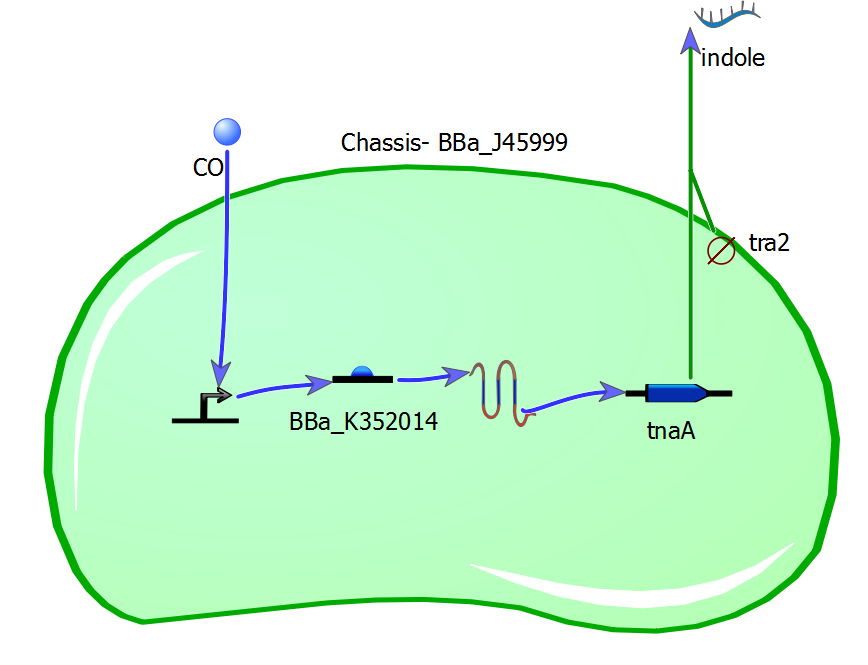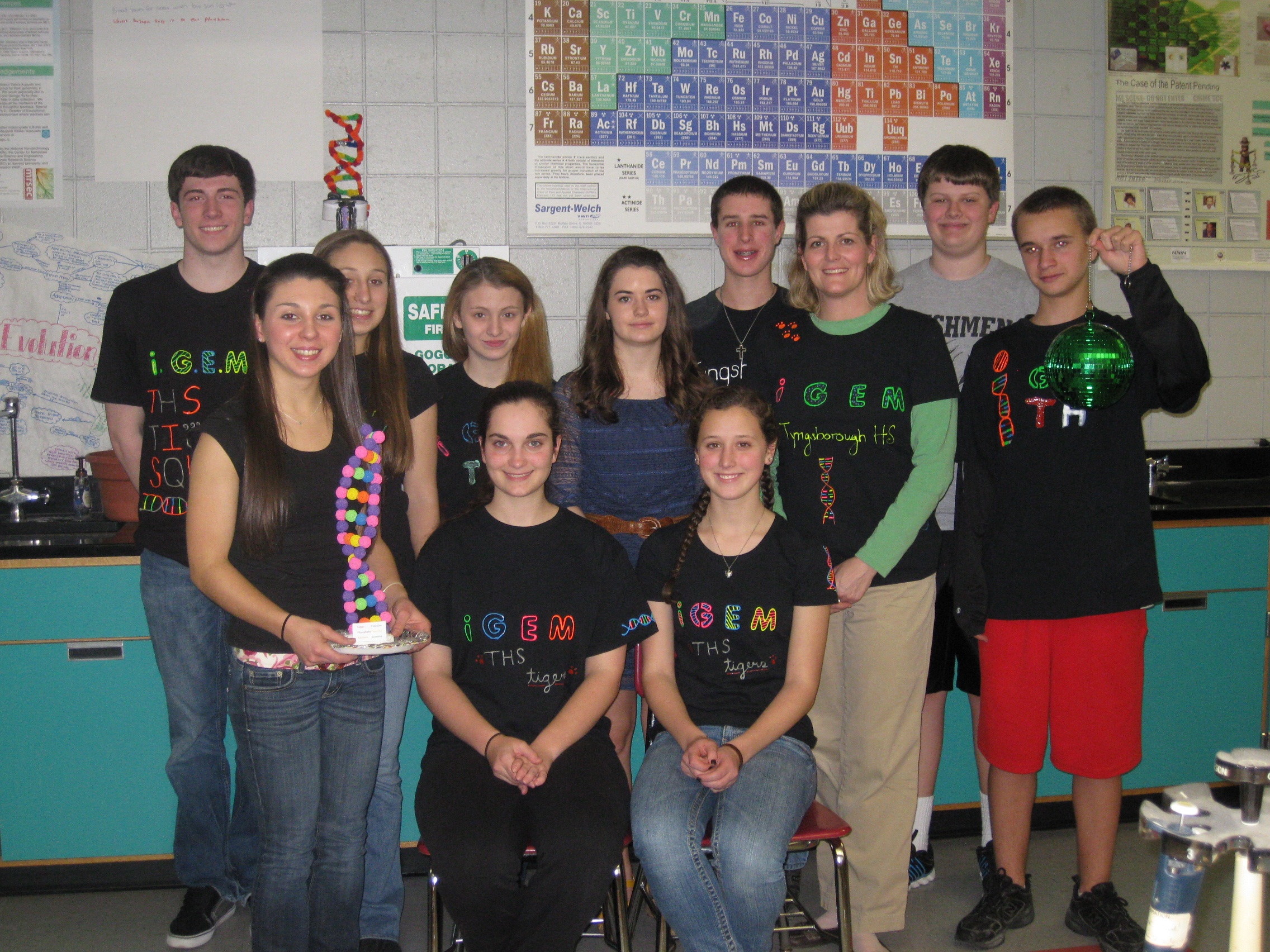Team:Tyngsboro MA Tigers
From 2012hs.igem.org
(→Project Description) |
(→Notebook) |
||
| Line 88: | Line 88: | ||
'''Fundraising''' | '''Fundraising''' | ||
| - | |||
| - | The second fundraiser our team set up was to run the concession stand at one of the girl's varsity basketball game. Our principal kindly allowed us to sell pizza, candy, drinks, and once again, homemade baked goods, for the concessions at our High School's girl's varsity basketball game. We set up a table outside the gym and during the game, sold all of the food to make a profit of | + | The first fundraiser our team set up was a bake sale at a local sports complex. The Tyngsborough Sports Center was generous enough to allow us to set up a table one Saturday in December and we sold an assortment of homemade baked goods and ornaments. Since it was close to Christmas, our team had a meeting just dedicated to making ornaments out of pipe cleaners which we dipped in '''(what was it again?)''' to crystallize them. The day of the fundraising, team members came in for their designated shifts throughout the day and we all brought different types of baked goods to sell as well. Making the ornaments was a fun team activity and we also had fun spending time together at our different shifts. Best of all, we made $300 for our team! |
| + | |||
| + | The second fundraiser our team set up was to run the concession stand at one of the girl's varsity basketball game. Our principal kindly allowed us to sell pizza, candy, drinks, and once again, homemade baked goods, for the concessions at our High School's girl's varsity basketball game. We set up a table outside the gym and during the game, sold all of the food to make a profit of $250. Overall Tyngsborough High School had a successful night because our iGEM team was able to raise even more money, and the girls team won the game! | ||
===Results/Conclusions=== | ===Results/Conclusions=== | ||
Revision as of 19:19, 15 March 2012
| You can write a background of your team here. Give us a background of your team, the members, etc. Or tell us more about something of your choosing. | |
|
Tell us more about your project. Give us background. Use this as the abstract of your project. Be descriptive but concise (1-2 paragraphs) | File:Tyngsboro MA Tigers team.png Your team picture |
| Team Tyngsboro_MA_Tigers |
| Official Team Profile |
|---|
Contents |
Team
We're the twelve-strong inaugural Tiger Squad at Tyngsborough High School in Tyngsborough, Massachusetts, with a real interest in using our science knowledge to help the community and learn about synthetic biology along the way!
Instructors
Students
Kathleen Barrett (Liaison)
Mia Pavao (Secretary)
Lizzy Seltz (Lab Manager)
Michael Sheets (Media Specialist)
Elizabeth Barrett (Public Relations)
Madison Vigneault (co-Treasurer)
Taylor Vigneault (co-Treasurer)
Brian Fidler (Morale Booster)
Kevin Barrett (Programmer)
Shannon Jackson (Business Coordinator)
Brian Parlee (Tech Support)
Project Description
eCOlifactory
Currently, the common household carbon monoxide detectors on the market are only sound-based. However, as people age, their senses aren't quite what they used to be, and our cell could help save even more lives with another sensory warning of the hidden danger. Also, many work places, such as construction sites, are extremely loud, easily loud enough to drown out the little beeping of a sensor, however, a disgusting and identifiable smell permeating through the compound could again save even more lives. Coupled with the common household detector, our cell could greatly reduce the number of CO deaths per year.
A colorless, odorless, and soundless killer takes the lives of nearly 2,100 unsuspecting United States citizens every year; that translates to an average of three people every day. Carbon monoxide poisoning is the leading cause of unintentional poisoning deaths in the United States, and one in every 2,400 people falls victim to CO poisoning, unaware of the invisible attacker. Males are 2.3 times more likely to die from CO poisoning than females, and people over the age of 65 have the highest risk of falling victim to this silent killer (utahpersonalinjurylawfirm.com). Only by being aware of the grave danger, and understanding the structure and works of the gas, we can create a circuit that gives a scent to CO and a warning before it's too late.
We are looking to develop a genetic circuit for bacteria that converts the odorless carbon monoxide into a malodorous output. Coupled with the common household detector, we might be able to reduce even further CO-related deaths.
R. rubrum:
Rhodospirillum rubrum is a bacterium that uses carbon monoxide as an energy source. This photosynthetic bacterium can metabolize carbon monoxide in the reaction: CO + H2O --> CO2 + H2
The enzyme carbon monoxide dehydrogenase (CODH) is a peripheral membrane protein that carries out the primary oxidation of CO to CO2 and then passes the products through a ferredoxin-like sub-unit. R. rubrum also has a carbon monoxide-sensing protein called CooA that activates the gene expression of oxidation enzymes. In our research on R. rubrum, we found that a Turkey iGEM team in the 2010 college division developed CooA and CooA-responsive promoter biobricks they wanted make to transform into E. coli. They were able to successfully build these parts, and now our goal is to try and put them into our own genetic circuit that, in the presence of carbon monoxide, will output an unpleasant warning smell.
Notebook
Finding Our Idea
3/15- What should our project name be? --should we be boring and say what it does-- what about "An olfactory system for the detection of carbon monoxide"-- should it start with " E. COLi factory:"-- Our final choice is.... "E. COLfactory: A smell test for the detection of carbon monoxide"
Creating the Genetic Circuit Once we had our idea solidified, the next step was coming up with a circuit to make our idea into a reality. Using the [http://www.tinkercell.com/ TinkerCell] program to create an example of the cell, we wanted to follow the KISS rule and keep things as simple as possible. The 2010 METU iGEM team created a [http://partsregistry.org/wiki/index.php?title=Part:BBa_K352014 part] that successfully detected carbon monoxide, and contained a Lacl promoter, RBS, and CooA, but from that point what the output was seemed to be fairly open for change. We wanted the output smell to be very unpleasant and trigger a negative response, and decided indole, the smell naturally made by e. coli, would be an excellent choice. We chose tnaA, the indole producing gene, as the last major step in our genetic sequence, and an [http://partsregistry.org/wiki/index.php?title=Part:BBa_J45999 odorless chassis] so that indole wouldn't be naturally produced by the detector.
Obstacles in creating the circuit were finding a tnaA producing gene (still working on that) and...
The parts chosen were all marked as 'working' in the parts registry, and most had the same assembly methods, making them compatible. Our major concerns are that we won't be able to find a tnaA gene by itself, or that the parts chosen won't work be compatible in practice.
Also, special thanks go out to our iGEM adviser, Alyssa Henning!

Fundraising
The first fundraiser our team set up was a bake sale at a local sports complex. The Tyngsborough Sports Center was generous enough to allow us to set up a table one Saturday in December and we sold an assortment of homemade baked goods and ornaments. Since it was close to Christmas, our team had a meeting just dedicated to making ornaments out of pipe cleaners which we dipped in (what was it again?) to crystallize them. The day of the fundraising, team members came in for their designated shifts throughout the day and we all brought different types of baked goods to sell as well. Making the ornaments was a fun team activity and we also had fun spending time together at our different shifts. Best of all, we made $300 for our team!
The second fundraiser our team set up was to run the concession stand at one of the girl's varsity basketball game. Our principal kindly allowed us to sell pizza, candy, drinks, and once again, homemade baked goods, for the concessions at our High School's girl's varsity basketball game. We set up a table outside the gym and during the game, sold all of the food to make a profit of $250. Overall Tyngsborough High School had a successful night because our iGEM team was able to raise even more money, and the girls team won the game!
Results/Conclusions
What did you achieve over the course of your semester?
Safety
What safety precautions did your team take? Did you take a safety training course? Were you supervised at all times in the lab?
Each member of the Tyngsborough Igem Tiger Squad has learned and currently follows the Flynn's scientific safety contract. Each new year, we take a scientific safety refresher to brush up on our safety procedures. We are all supervised in our labs by our instructors Mrs. Boughan and Mrs. Ravigala.
Here is a link to youtube to watch a funny safety video on what NOT to do in a lab setting.
[http://www.youtube.com/watch?v=GOQAq4Nl4og Click here for video] All credit goes to the producer of the video Zach Lipovsky
Attributions
Who worked on what?
References
"Carbon Monoxide Poisoning Statistics." Christensen Law Firm. 03 Sept. 2010. Web. 1 Mar. 2012. [<http://www.utahpersonalinjurylawfirm.com/2010/09/carbon-monoxide-poisoning-statistics/>].
Human Practices
Currently, the common CO detectors on the market are only sound-based. However, as people age, their senses aren't quite what they used to be, and our cell could help save even more lives with another sensory warning of the hidden danger. Also, many work places, such as construction sites, are extremely loud, easily loud enough to drown out the little beeping of a sensor, however, a disgusting and identifiable smell permeating through the compound could again save even more lives. Coupled with the common household detector, our cell could greatly reduce the number of CO deaths per year.
Fun!
What was your favorite team snack?? Have a picture of your team mascot?
 "
"
